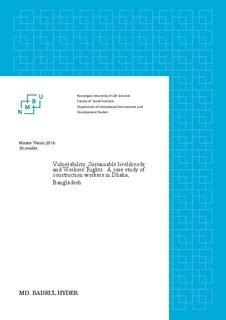| dc.description.abstract | Construction workers in Dhaka city are mainly migrant workers from rural Bangladesh. They migrate to Dhaka city to overcome the vulnerability context and to secure a sustainable livelihood. However, workers’ vulnerability and sustainable livelihoods largely depend on their livelihood assets and occupational activities. Therefore, in the first stage, this research attempted to explore workers’ vulnerability considering the reduction of livelihood assets and occupational activities. The reduction of livelihood assets has considered the assets changes because of migration, and occupational activities have considered the working conditions at workplace. I developed a vulnerability index for measuring workers’ livelihood vulnerability in the quantitative segment of this research. The quantitative findings of the research suggest that other than financial capital, workers vulnerability indexes on the four assets (Human, social, physical and natural) in Dhaka are comparatively higher than the context of the
village. This suggests construction workers might be slightly more vulnerable in Dhaka
compared with their life in village. Considering all the values of asset’s indicators for both
Dhaka and the village, the P-value of a paired t-test is 0.05 which validates that there is some evidence against the research’s null hypothesis, and the research accepts the alternative hypothesis; - construction workers are more vulnerable in urban context compared with their rural context. In addition, the workplace vulnerability index suggests that workers are acutely vulnerable in their workplace. In the final stage, a qualitative research has studied the violation of workers’ rights and its impact on workers’ livelihood. Qualitative findings of the final stage suggest that workers usually receive minimum safety and welfare facilities, which mean they work in unsafe and risky conditions, making them even more vulnerable in the workplace. Also, Workers cannot demand their rights because they are afraid of losing their jobs; as they are easily replaceable by other jobless poor workers. Workers do not or cannot claim any compensation due to the lack of a written contract. Therefore, it reveals that workers need their rights protected more than their livelihood assets, in order to cope and adapt with vulnerability in the village and to secure a sustainable livelihood. | nb_NO |

